This is my grad project,
completed during the fourth year of my bachelors degree (2017-2018).
Why don’t I talk about racism
in Canada?
While spending a semester in the US I noticed how frequently people around me were talking openly about racism. When I returned to Canada I became very aware that many of us do not actively acknowledge racism as a serious problem here in our own country. Why is this?
Canada’s Hidden Racism is a video exploring perspectives and lived experiences of racism in Canada. Using existing documentation, the video seeks to challenge white Canadians with the prevalence, pain, and lasting effects of racism that we may be unaware of. Found footage, text, numeric data and narrative are employed in the video to engage an audience in a way that encourages reflection and questioning. Can this approach succeed in raising awareness and care?
Methodology Overview
We need to stop asking if racism is a problem here, and talk about why it is a problem here.
With this project, I wanted to create an awareness campaign that would show the overwhelming amount of pain caused by racism here in Canada, pointing at the excuse that multiculturalism gives us not to worry about it. My audience consists of Canadian adults who are unaware of the pervasiveness and abundance of racism in Canada, and don’t consider it to be a serious issue here. There is a lot that isn’t taught in schools about Canada’s history (like slavery), which contributes to the perception of ourselves as kind, polite Canadians. My campaign does not serve to educate about these issues but to introduce to the viewer the idea that there may be things they don’t know about our history, things that our national story denies.
Rather than trying to incentivize care (as many campaigns do), I am using the tactic of addressing barriers to change, as it is thought to be a more successful approach. My project is specifically aimed at the unawareness that privileged people have (due to many factors such as upbringing and colonialist, eurocentric education) which prevents us from seeing the problems that our fellow citizens are experiencing right before our eyes.
We need to stop asking if racism is a problem here, and talk about why it is a problem here.
With this project, I wanted to create an awareness campaign that would show the overwhelming amount of pain caused by racism here in Canada, pointing at the excuse that multiculturalism gives us not to worry about it. My audience consists of Canadian adults who are unaware of the pervasiveness and abundance of racism in Canada, and don’t consider it to be a serious issue here. There is a lot that isn’t taught in schools about Canada’s history (like slavery), which contributes to the perception of ourselves as kind, polite Canadians. My campaign does not serve to educate about these issues but to introduce to the viewer the idea that there may be things they don’t know about our history, things that our national story denies.
Rather than trying to incentivize care (as many campaigns do), I am using the tactic of addressing barriers to change, as it is thought to be a more successful approach. My project is specifically aimed at the unawareness that privileged people have (due to many factors such as upbringing and colonialist, eurocentric education) which prevents us from seeing the problems that our fellow citizens are experiencing right before our eyes.
Outcome
In order to reach my audience, I decided to use video to integrate multiple modes of communication into one experience. I am not concerned with reaching people who have experienced racism, as they are surely aware of its effects and prevalence in Canada. For that reason, I use words like “us” and “we” to speak to white people (like me) who are lucky enough never to have been victims of racism.
I have used existing documentation of Canadians talking about their experiences with racism and how it has affected them. It is important to see the long-lasting effects that racism has, as this re-enforces the significance of the issue.
I hope to influence those who watch the video so that they walk away with something new to think about. If people take in the stories, information and implications about racism, and sit with it, carry it with them, revisit it, investigate it, and talk about it with their peers, they will become actively engaged in the issue. I believe it is the responsibility of every Canadian to care that the people around them are experiencing both crude and hidden racism, to witness it, and support them.
In order to reach my audience, I decided to use video to integrate multiple modes of communication into one experience. I am not concerned with reaching people who have experienced racism, as they are surely aware of its effects and prevalence in Canada. For that reason, I use words like “us” and “we” to speak to white people (like me) who are lucky enough never to have been victims of racism.
I have used existing documentation of Canadians talking about their experiences with racism and how it has affected them. It is important to see the long-lasting effects that racism has, as this re-enforces the significance of the issue.
I hope to influence those who watch the video so that they walk away with something new to think about. If people take in the stories, information and implications about racism, and sit with it, carry it with them, revisit it, investigate it, and talk about it with their peers, they will become actively engaged in the issue. I believe it is the responsibility of every Canadian to care that the people around them are experiencing both crude and hidden racism, to witness it, and support them.
I also wrote an article detailing the design choices I made in regards to concept and development of this project. It was published by Current, Emily Carr University’s own design research journal in Current 08: Generative Research and Social Innovation.
Exhibition

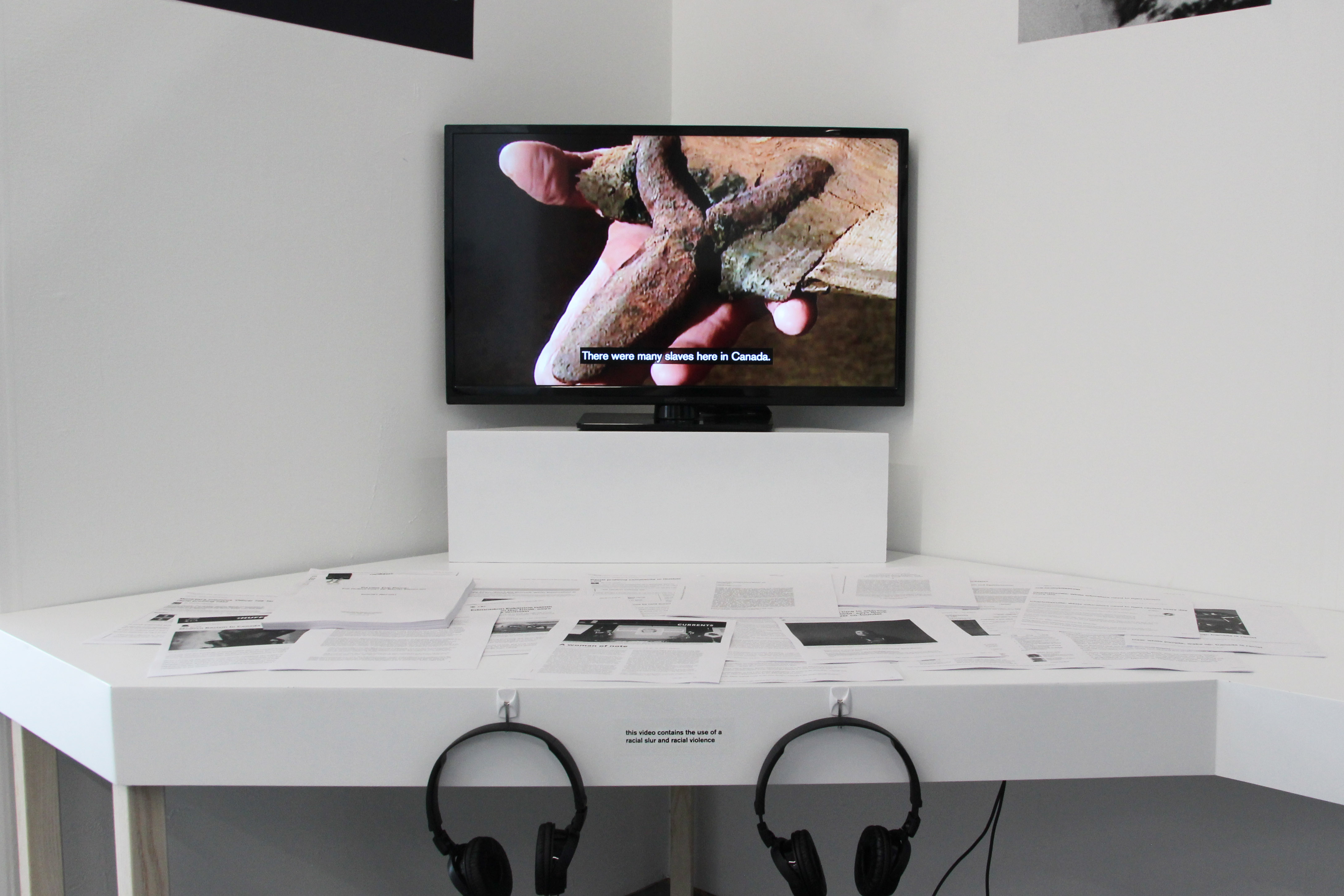


Canada’s Hidden Racism was exhibited at THE SHOW at Emily Carr University from May 5–20 2018. This was a great opportunity to reach my audience. From the amount of engagement I observed during the opening night, the video and exhibit was successful in intriguing viewers and holding their interest long enough to watch most (or all) of the video.
Research
Research and final product were prioritized in the exhibition of the project. Research was the primary aspect of this project, and it is something that I wanted to promote and showcase. Across the table I displayed some of the secondary research that was used in the video, and some that was used to validate its purpose.
Captions
Captions allowed those hard of hearing to experience the video, and engaged passersby who caught a glimpse and wanted to see more.
Takeaways
I provided risograph printed takeaways for my exhibit which gave people the option to watch the video at home by going to the website. The takeaways also displayed the core story of the project—a statement contextualizing the video by explaining what lead me to make it. The core story also states what the design project is, and lists the materials used in the video. It reveals the intent of the project by prompting viewers with questions to encourage them to question what they think of the perspectives shown in the project.
I provided risograph printed takeaways for my exhibit which gave people the option to watch the video at home by going to the website. The takeaways also displayed the core story of the project—a statement contextualizing the video by explaining what lead me to make it. The core story also states what the design project is, and lists the materials used in the video. It reveals the intent of the project by prompting viewers with questions to encourage them to question what they think of the perspectives shown in the project.

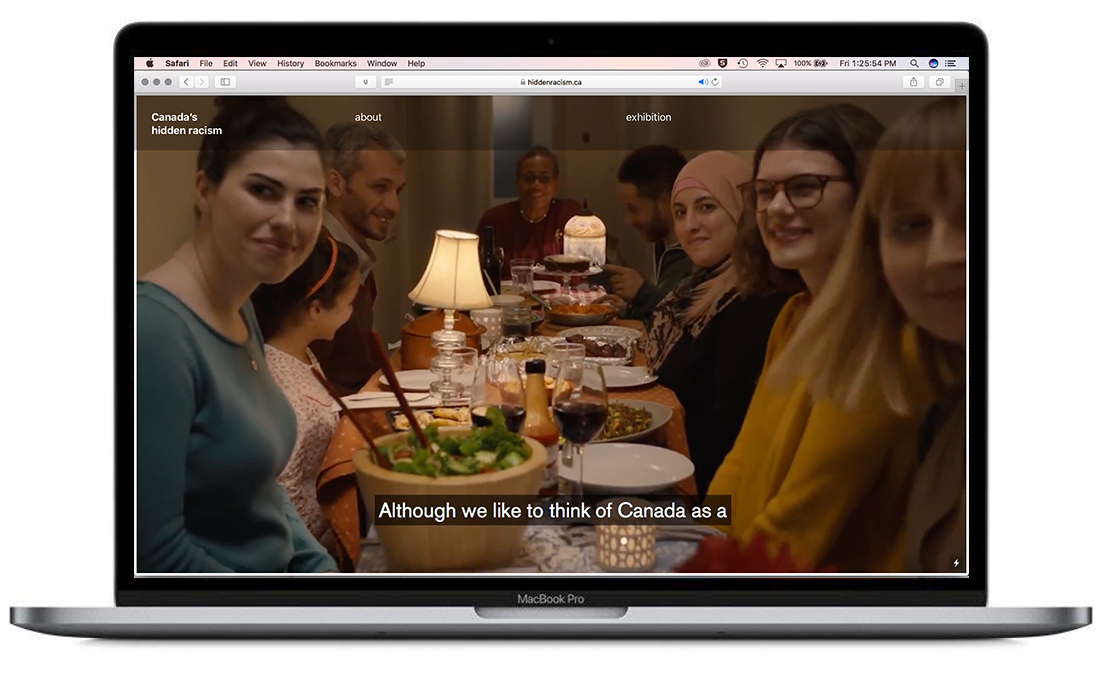
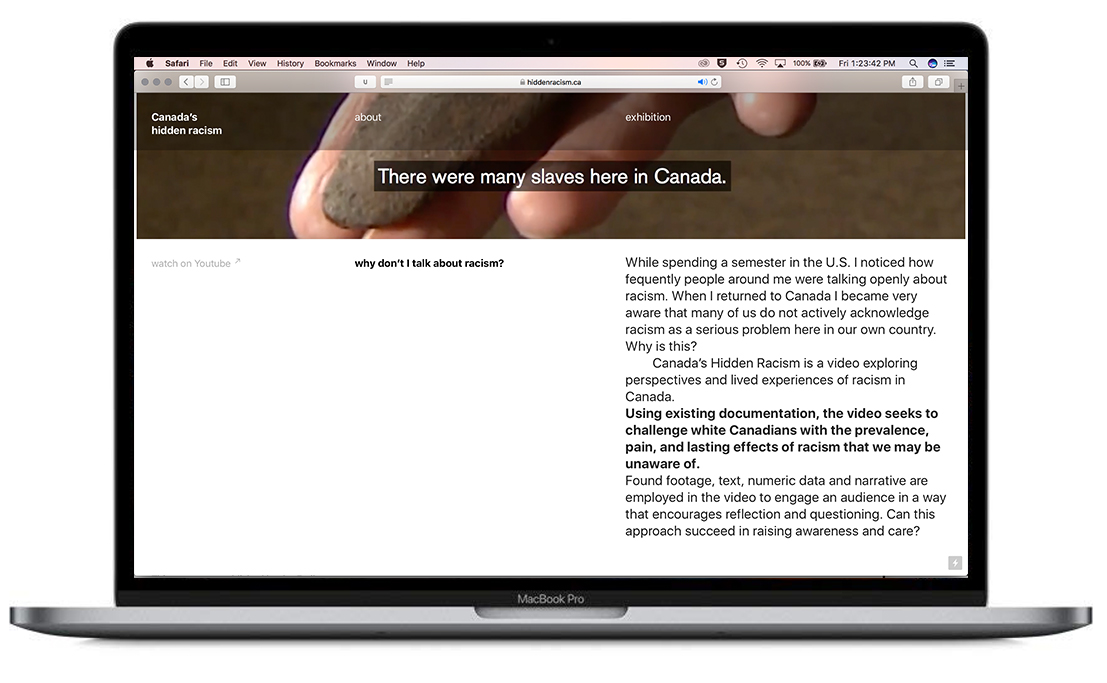
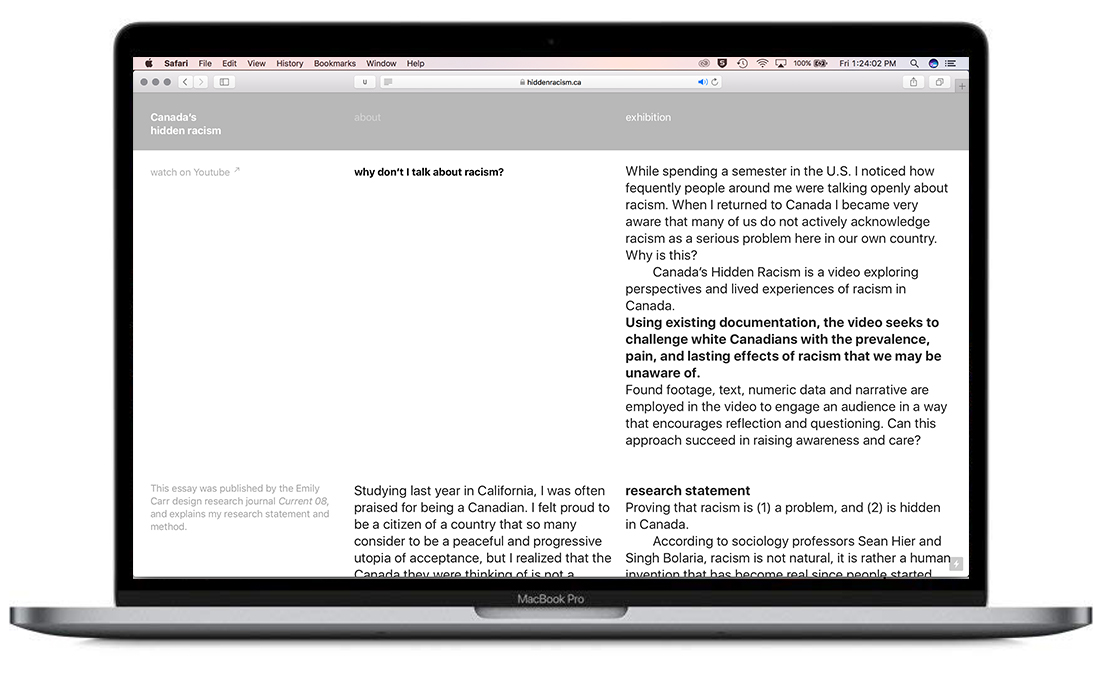
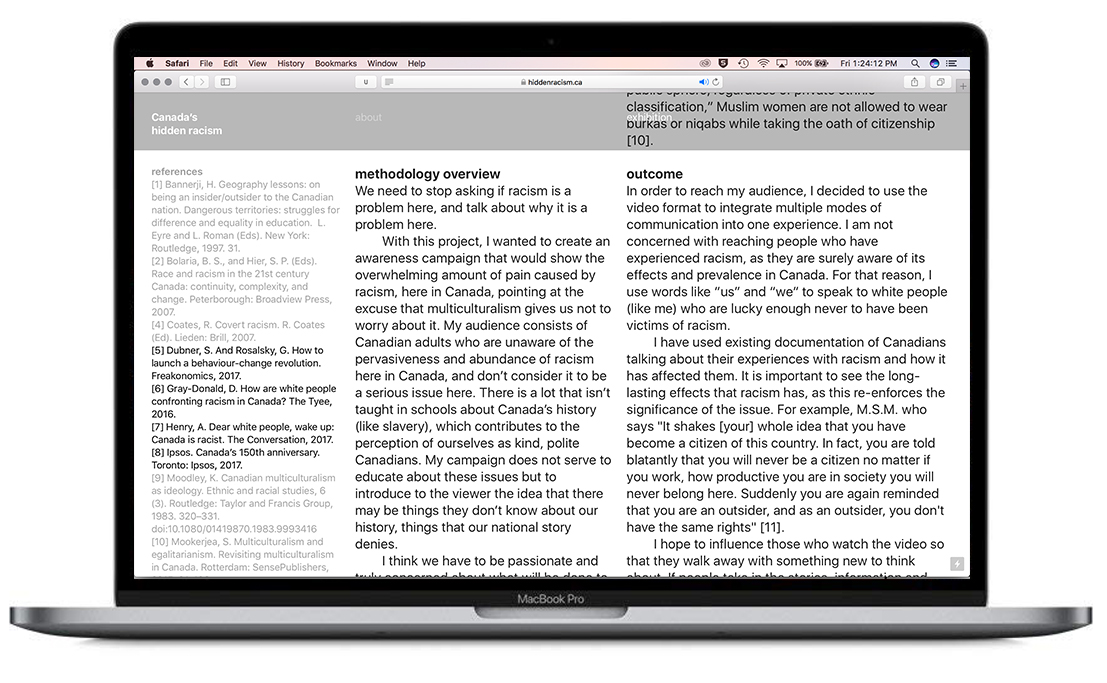


Online
hiddenracism.ca allowed people to watch the video and read more about the project after seeing it at the exhibition. There, they could view the video in a more private setting, and have more time to think and explore the resources listed. The website was live until September 2018.
Hindsight in 2021
Right now I am happy that the youtube video isn’t popular and doesn’t need to be. There are so many better resources out there that accomplish what I had hoped to!
I have edited and re-uploaded the youtube video twice since it’s inital posting in 2018. Rather than continuing to try to improve it, I’m getting ready to retire the video and remove it completely. It’s a good thing!
I always knew that as I learned more I would potentially regret doing this project as I learn about mistakes I made during the process, and harm that I may have caused in creating this as a white settler in unceded lands.
This project is supposed to promote the ideas and opinions of others who are more knowledgeable on the subject of racism in Canada. I don’t think that I really did that in the way that I wanted to.
This project is supposed to promote the ideas and opinions of others who are more knowledgeable on the subject of racism in Canada. I don’t think that I really did that in the way that I wanted to.